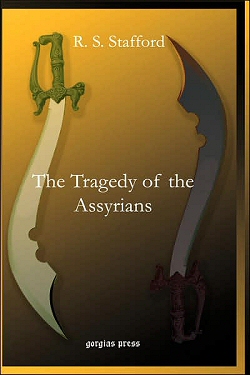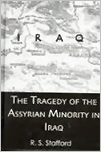The Tragedy of the AssyriansPosted: Sunday, February 22, 2004 at 01:17 PM CT
|
||||||||||
| Amazon | Barnes & Noble | Books-A-Million | Find in a Library | |
| Gorgias Press LLC | Kegan Paul International |
| ISBN-10: 1593334133 ISBN-13: 978-1593334130 Language: English Binding: Hardcover Number of Pages: 224 pages Publisher: Gorgias Press LLC Published Date: December 28, 2006 Product Dimensions: 9.2 x 5.9 x 0.8 inches |
ISBN: 0710308930 ISBN-13: 9780710308931, 978-0710308931 Language: English Binding: Hardcover Number of Pages: 256 Publisher: Kegan Paul International Publishing Date: May 27, 2005 Academic/Grade Level: Scholarly/Undergraduate |
About the Author (excerpt from Gorgias Press, eGorgias June 2007 newsletter)
 Ronald Stafford was born in Buenos Aires in 1890, the son of Edward Stafford and Teresa (Kruls) whose father was an Argentinean (but originally Dutch) and whose mother was an Argentinean. They moved to England when Ronald was seven months old. At Cambridge University, his first degree was in Latin and Greek and his second degree was Arabic and French, as he had already decided to join the British Colonial Service. In 1913 he sailed to Cairo as a trainee inspector working for the Egyptian Government which was advised by the British administration. At the outbreak of World War I in 1914 he volunteered immediately but he was at first refused permission to leave, finally arriving in England early in 1915. He was commissioned at once into the 60th Rifles, one of the best of the British infantry regiments. By May 1915 he was in the front line. He spent the next three years almost continuously in the line, commanding his regiment in 1918 as a Lieutenant Colonel at the age of 28. He was awarded the DSO and bar, the MC and was once recommended for the VC. By pure good fortune he was only once slightly wounded. Like so many others who fought in the trenches, he spoke little about these experiences but he was a brave man and a good leader. (Stafford's grandson, Alastair Smith, adds that, after his grandfather’s death in 1972, his ashes were scattered [as was his wish] at the site of the 1916 battle of Delville Wood in Northern France, a battle in which his battalion lost almost two thirds of their strength.)
Ronald Stafford was born in Buenos Aires in 1890, the son of Edward Stafford and Teresa (Kruls) whose father was an Argentinean (but originally Dutch) and whose mother was an Argentinean. They moved to England when Ronald was seven months old. At Cambridge University, his first degree was in Latin and Greek and his second degree was Arabic and French, as he had already decided to join the British Colonial Service. In 1913 he sailed to Cairo as a trainee inspector working for the Egyptian Government which was advised by the British administration. At the outbreak of World War I in 1914 he volunteered immediately but he was at first refused permission to leave, finally arriving in England early in 1915. He was commissioned at once into the 60th Rifles, one of the best of the British infantry regiments. By May 1915 he was in the front line. He spent the next three years almost continuously in the line, commanding his regiment in 1918 as a Lieutenant Colonel at the age of 28. He was awarded the DSO and bar, the MC and was once recommended for the VC. By pure good fortune he was only once slightly wounded. Like so many others who fought in the trenches, he spoke little about these experiences but he was a brave man and a good leader. (Stafford's grandson, Alastair Smith, adds that, after his grandfather’s death in 1972, his ashes were scattered [as was his wish] at the site of the 1916 battle of Delville Wood in Northern France, a battle in which his battalion lost almost two thirds of their strength.)
In 1919 he returned to Egypt and was appointed Inspector for Lower Egypt (the Nile Delta) at a time when security was poor after demonstrations against the British presence. In 1926 he took up a post as a District Inspector in Iraq, a newly created country following the collapse of the Ottoman Empire. This was a happy and successful period of his life, married (to Mary Dixon) with two small children, and making many friends amongst the Iraqis. In 1933 he repeatedly warned the Iraqi Government that unless certain sections of the Army could be restrained there would be a massacre of Assyrian Christians. He demanded that those responsible should be punished and when the Government told him that this was impossible he resigned. He was urged to stay - the Iraqi ministers saying that of all the British officials he was the one they most respected - but he refused to change his mind.
Ronald Stafford returned to England and wrote The Tragedy of the Assyrians. In 1936, he joined the British Broadcasting Company (BBC) and worked there until he retired in 1952.
Google Books online - The Tragedy of the Assyrians
![]() The Tragedy of the Assyrian Minority in Iraq - Amazon's online bookstore.
The Tragedy of the Assyrian Minority in Iraq - Amazon's online bookstore.
Related Information

 Contents
Contents Government Forum
Government Forum Government and Political Information
Government and Political Information